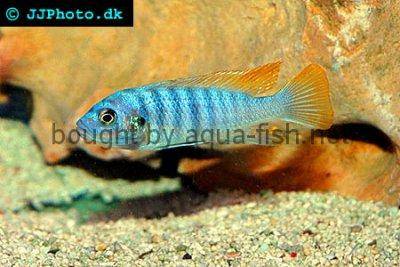William’s mbuna - Maylandia greshakei
Scientific name: Maylandia greshakei
Common name: William’s mbuna
Family: Cichlidae
Usual size in fish tanks: 12 - 14 cm (4.72 - 5.51 inch)
014
Recommended pH range: 6.8 - 7.6
Recommended water hardness: 7 - 23°N (125 - 410.71ppm)
0°C 32°F30°C 86°F
Recommended temperature range: 23 - 26 °C (73.4 - 78.8°F)
The way how these fish reproduce: Spawning
Where the species comes from: Africa
Temperament to its own species: peaceful
Temperament toward other fish species: aggressive to smaller
Usual place in the tank: Bottom levels
Origin
The William’s Mbuna (Maylandia greshakei) hails from the freshwater habitats of Africa, specifically the rocky shores of Lake Malawi. This region's unique environment provides them with numerous rock formations, which they use for shelter, territory, and grazing.
Short Description
William’s Mbunas are renowned for their vibrant colors and semi-aggressive nature, particularly towards smaller fish. In aquariums, they typically grow to a size of 12-14 cm (4.72-5.51 inches). To minimize aggression, it is advisable to avoid housing them with other Mbuna species of similar coloration. A well-decorated tank with ample rockwork and hiding places is crucial. Additionally, performing regular water changes is essential to maintain water quality and keep these fish active and healthy.
Lifespan
When provided with proper care, William’s Mbuna can live for 5-8 years, making them a long-term and colorful addition to your aquarium setup.
General Care
These cichlids thrive in a spacious aquarium with plenty of rockwork that creates natural hiding spots and establishes territories. They prefer water temperatures between 23-26°C (73.4-78.8°F), a pH level of 6.8-7.6, and water hardness in the range of 7-23°N (125-410.71 ppm). Due to their aggressive behavior towards smaller fish, it is best to house them with similarly sized, robust tank mates. Regular water changes are necessary to maintain optimal conditions, reduce stress, and promote overall health.
Food and Feeding
In their natural habitat, William’s Mbunas primarily feed on plankton. In captivity, a vegetable-based diet is vital. Provide a high-quality flake food, supplemented with spirulina flakes and Nori. Incorporating a variety of plant-based foods will help maintain their vibrant coloration and support their digestive health. For more feeding tips, check out our guide on feeding cichlids.
Sexing
Sexing William’s Mbunas can be done by observing size and coloration differences. Males are typically slightly larger than females and exhibit more intense coloration. This visual method is generally the most reliable way to distinguish between the sexes.
Breeding
For successful breeding, it is recommended to keep one male with multiple females to reduce the risk of aggression. During spawning, the female will scoop up the eggs into her mouth, where she will brood them for up to three weeks. After the fry are released, they can be fed with newly hatched brine shrimp or finely crushed flake food to promote healthy growth.
Additional Notes
Due to their semi-aggressive nature, William’s Mbunas are best suited for aquarists with experience managing cichlid tanks. Creating an environment that closely resembles their natural habitat, with plenty of rockwork and regular water changes, can significantly reduce stress and aggressive behaviors. Consistent monitoring of water quality and maintaining a balanced diet are essential for their long-term well-being.
Pictures
Bought by aqua-fish.net from jjphoto.dk.




 Thread-finned
Thread-finned  Acara
Acara  Yellow
Yellow  Patrick's
Patrick's  Blue
Blue  Green
Green  Acara
Acara  White
White  Compressed
Compressed  Pastel
Pastel  Midas
Midas  Red
Red  Bluemouth
Bluemouth  False
False  African
African  Agassiz's
Agassiz's  Banded
Banded  Yellow
Yellow  Cockatoo
Cockatoo  Blue
Blue  Blackstripe
Blackstripe  Highfin
Highfin  Redstripe
Redstripe  Threadfinned
Threadfinned  Macmaster’s
Macmaster’s  Panda
Panda  Norbert’s
Norbert’s  Blue
Blue  Thin-line
Thin-line  Three-striped
Three-striped  Viejita
Viejita  Flier
Flier  Archocentrus
Archocentrus  Convict
Convict  Seven
Seven  Spiny
Spiny  Oscar
Oscar  Sunshine
Sunshine  Chitande
Chitande  Firebird
Firebird  Midnight
Midnight  Lake
Lake  Sunshine
Sunshine  Aulonocara
Aulonocara  Nyasa
Nyasa  Ruby
Ruby  Grants
Grants  Aulonocranus
Aulonocranus  Chameleon
Chameleon  Benitochromis
Benitochromis  Orinoco
Orinoco  Yellow
Yellow  Brichard’s
Brichard’s  Guenther’s
Guenther’s  Southern
Southern  Cichla
Cichla  Peacock
Peacock  Chiseltooth
Chiseltooth  Bolivian
Bolivian  Red
Red  Many-pointed
Many-pointed  Jack
Jack  Red
Red  Three
Three  Keyhole
Keyhole  Azureus
Azureus  Red
Red  Jackson’s
Jackson’s  Crenicichla
Crenicichla  Honduran
Honduran  Blue-eye
Blue-eye  Afra
Afra  Frontosa
Frontosa  Slender
Slender  Malawi
Malawi  Chequerboard
Chequerboard  Checkerboard
Checkerboard  Malawi
Malawi  Ectodus
Ectodus  Tanganyika
Tanganyika  Canara
Canara  Green
Green  Rostratus
Rostratus  Pearl
Pearl  Geophagus
Geophagus  Yellowhump
Yellowhump  Suriname
Suriname  Redhump
Redhump  Red
Red  Dority’s
Dority’s  Argentine
Argentine  Burton’s
Burton’s  Victoria
Victoria  Haplochromis
Haplochromis  Jewel
Jewel  Banded
Banded  Lifalili
Lifalili  Lowland
Lowland  Texas
Texas  Pantano
Pantano  Severum
Severum  Banded
Banded  Severum
Severum  Rainbow
Rainbow  Parrot
Parrot  Chocolate
Chocolate  Brown
Brown  Marlieri
Marlieri  Golden
Golden  Striped
Striped  Masked
Masked  Konye
Konye  Blue
Blue  Trewavas
Trewavas  Electric
Electric  Dwarf
Dwarf  Redbreast
Redbreast  Lamprologus
Lamprologus  Gold
Gold  Greenface
Greenface  Mayan
Mayan  Aurora
Aurora  Blue
Blue  Zebra
Zebra  Malawi
Malawi  Blue
Blue  Blue
Blue  Mbuna
Mbuna  Parallel
Parallel  Purple
Purple  Flag
Flag  Bolivian
Bolivian  Ram
Ram  Basket
Basket  Haitian
Haitian  Zebra
Zebra  Striped
Striped  Neolamprologus
Neolamprologus  Brevis
Brevis  Fairy
Fairy  Neolamprologus
Neolamprologus  Cylindricus
Cylindricus  Hecq’s
Hecq’s  Neolamprologus
Neolamprologus  Lemon
Lemon  Mustax
Mustax  Daffodil
Daffodil  Six-bar
Six-bar  Five-bar
Five-bar  Marbled
Marbled  Giraffe
Giraffe  Blue
Blue  Sulphurhead
Sulphurhead  Wolf
Wolf  Jaguar
Jaguar  Blue
Blue  Marakeli
Marakeli  Madagascar
Madagascar  Pinstripe
Pinstripe  Pelmatochromis
Pelmatochromis  Kribensis
Kribensis  Striped
Striped  Red
Red  Deepwater
Deepwater  Fenestratus
Fenestratus  Nichols’
Nichols’  Southern
Southern  Bumble
Bumble  Demason’s
Demason’s  Slender
Slender  Red
Red  Mbuna
Mbuna  Malawi
Malawi  Kenyi
Kenyi  Powder
Powder  Altum
Altum  Angelfish
Angelfish  Angelfish
Angelfish  East
East  Juba
Juba  Earth
Earth  Electric
Electric  Azure
Azure  Lionhead
Lionhead  Discus
Discus  Blue
Blue  Red
Red  Zebra
Zebra  Brichard’s
Brichard’s  Blue
Blue  Firemouth
Firemouth  Zebra
Zebra  Yellow
Yellow  Blue
Blue  Dwarf
Dwarf  Blunthead
Blunthead  The
The  White
White  Twoband
Twoband  Fenestratus
Fenestratus  Window
Window  Tailbar
Tailbar  Black
Black  Redhead
Redhead  Oaxaca
Oaxaca  Xenotilapia
Xenotilapia